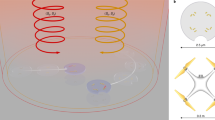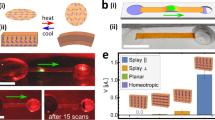Abstract
Axonal path-finding is important in the development of the nervous system, nerve repair and nerve regeneration. The behaviour of the growth cone at the tip of the growing axon determines the direction of axonal growth and migration. We have developed an optical-based system to control the direction of growth of individual axons (nerve fibres) using laser-driven spinning birefringent spheres. One or two optical traps position birefringent beads adjacent to growth cones of cultured goldfish retinal ganglion cell axons. Circularly polarized light with angular momentum causes the trapped bead to spin. This creates a localized microfluidic flow generating an estimated 0.17 pN shear force against the growth cone that turns in response to the shear. The direction of axonal growth can be precisely manipulated by changing the rotation direction and position of this optically driven micromotor. A physical model estimating the shear force density on the axon is described.
This is a preview of subscription content, access via your institution
Access options
Subscribe to this journal
Receive 12 print issues and online access
$209.00 per year
only $17.42 per issue
Buy this article
- Purchase on Springer Link
- Instant access to full article PDF
Prices may be subject to local taxes which are calculated during checkout





Similar content being viewed by others
References
Ming, G. L. et al. Adaptation in the chemotactic guidance of nerve growth cones. Nature 417, 411–418 (2002).
Patel, N. & Poo, M. M. Orientation of neurite growth by extracellular electric–fields. J. Neurosci. 2, 483–496 (1982).
Patel, N. B. & Poo, M. M. Perturbation of the direction of neurite growth by pulsed and focal electric-fields. J. Neurosci. 4, 2939–2947 (1984).
Blau, A. et al. Promotion of neural cell adhesion by electrochemically generated and functionalized polymer films. J. Neurosci. Meth. 112, 65–73 (2001).
Luo, Y. & Shoichet, M. S. A photolabile hydrogel for guided three-dimensional cell growth and migration. Nature Mater. 3, 249–253 (2004).
Wu, T. et al. Neuronal growth cones respond to laser-induced axonal damage. J. R. Soc. Interface http://dx.doi.org/10.1098/rsif.2011.0351 (2011).
Ehrlicher, A. et al. Guiding neuronal growth with light. Proc. Natl Acad. Sci. USA 99, 16024–16028 (2002).
Stevenson, D. J. et al. Optically guided neuronal growth at near infrared wavelengths. Opt. Express 14, 9786–9793 (2006).
Carnegie, D. J., Stevenson, D. J., Mazilu, M., Gunn-Moore, F. & Dholakia, K. Guided neuronal growth using optical line traps. Opt. Express 16, 10507–10517 (2008).
Mathew, M. et al. Signalling effect of NIR pulsed lasers on axonal growth. J. Neurosci. Meth. 186, 196–201 (2010).
Harris, W. A., Holt, C. E. & Bonhoeffer, F. Retinal axons with and without their somata, growing to and arborizing in the tectum of Xenopus embryos—a time-lapse video study of single fibers in vivo. Development 101, 123–133 (1987).
Lowery, L. A. & Van Vactor, D. The trip of the tip: understanding the growth cone machinery. Nat. Rev. Mol. Cell Biol. 10, 332–343 (2009).
Friese, M. E. J., Nieminen, T. A., Heckenberg, N. R. & Rubinsztein-Dunlop, H. Optical alignment and spinning of laser-trapped microscopic particles. Nature 394, 348–350 (1998).
Bishop, A. I., Nieminen, T. A., Heckenberg, N. R. & Rubinsztein-Dunlop, H. Optical microrheology using rotating laser-trapped particles. Phys. Rev. Lett. 92, 198104 (2004).
Parkin, S. J. et al. Highly birefringent vaterite microspheres: production, characterization and applications for optical micromanipulation. Opt. Express 17, 21944–21955 (2009).
Knöner, G., Parkin, S., Heckenberg, N. R. & Rubinsztein-Dunlop, H. Characterization of optically driven fluid stress fields with optical tweezers. Phys. Rev. E 72, 031507 (2005).
Di Leonardo, R. et al. Multipoint holographic optical velocimetry in microfluidic systems. Phys. Rev. Lett. 96, 134502 (2006).
Leach, J., Mushfique, H., di Leonardo, R., Padgett, M. & Cooper, J. An optically driven pump for microfluidics. Lab. Chip 6, 735–739 (2006).
Franze, K. & Guck, J. The biophysics of neuronal growth. Rep. Prog. Phys. 73, 1–19 (2010).
Hudspeth, A. J. Making an effort to listen: mechanical amplification in the ear. Neuron 59, 530–545 (2008).
Ishijima, A., Doi, T., Sakurada, K. & Yanagida, T. Sub-piconewton force fluctuations of actomyosin in vitro. Nature 352, 301–306 (1991).
Liu, Y. et al. Evidence for localized cell heating induced by infrared optical tweezers. Biophys. J. 68, 2137–2144 (1995).
Tamada, A., Kawase, S., Murakami, F. & Kamiguchi, H. Autonomous right-screw rotation of growth cone filopodia drives neurite turning. J. Cell Biol. 188, 429–441 (2010).
Cojoc, D. et al. Properties of the force exerted by filopodia and lamellipodia and the involvement of cytoskeletal components. PloS One 2, e1072 (2007).
Chan, C. E. & Odde, D. J. Traction dynamics of filopodia on compliant substrates. Science 322, 1687–1691 (2008).
Hoffman-Kim, D., Mitchel, J. A. & Bellamkonda, R. V. Topography, cell response, and nerve regeneration. Annu. Rev. Biomed. Eng. 12, 203–231 (2010).
Oldenbourg, R., Katoh, K. & Danuser, G. Mechanism of lateral movement of filopodia and radial actin bundles across neuronal growth cones. Biophys. J. 78, 1176–1182 (2000).
Mallavarapu, A. & Mitchison, T. Regulated actin cytoskeleton assembly at filopodium tips controls their extension and retraction. J. Cell Biol. 146, 1097–1106 (1999).
Bates, C. A. & Meyer, R. L. Heterotrimeric G protein activation rapidly inhibits outgrowth of optic axons from adult and embryonic mouse, and goldfish retinal explants. Brain Res. 714, 65–75 (1996).
Landreth, G. E. & Agranoff, B. W. Explant culture of adult goldfish retina: a model for the study of CNS regeneration. Brain Res. 161, 39–53 (1979).
Parkin, S. et al. Optical torque on microscopic objects. Methods Cell Biol. 82, 525–561 (2007).
Acknowledgements
The authors thank H. Tucker for discussions on statistics and the software used to calculate the P-values of the Irwin–Fisher Exact Test, and S. George, H. Chan and C. Robertson for measuring the viscosity of the culture medium. This research was supported by a grant from the US Air Force Office of Scientific Research (no. FA9550-10-1-0538 to M.W.B.), a gift from the Beckman Laser Institute Foundation (to M.W.B.), a grant from the Australian Research Council (to T.A.N. and H.R.) and a School of Biological Sciences grant (to R.L.M.).
Author information
Authors and Affiliations
Contributions
T.W. performed all the experiments reported in this paper. S.M. performed seminal experiments that led to the studies reported here. T.A.N. and H.R.-D. developed the physical approximation model. J.M. prepared the goldfish retinal explant cultures. T.W., T.A.N., R.L.M., H.R.-D. and M.W.B. analysed the data. T.W., T.A.N., J.M., R.L.M., H.R.-D. and M.W.B. wrote the paper.
Corresponding author
Ethics declarations
Competing interests
The authors declare no competing financial interests.
Supplementary information
Supplementary information
Supplementary information (PDF 474 kb)
Supplementary information
Supplementary Movie (MOV 397 kb)
Supplementary information
Supplementary Movie (MOV 645 kb)
Supplementary information
Supplementary Movie (MOV 4239 kb)
Supplementary information
Supplementary Movie (MOV 218 kb)
Supplementary information
Supplementary Movie (MOV 239 kb)
Rights and permissions
About this article
Cite this article
Wu, T., Nieminen, T., Mohanty, S. et al. A photon-driven micromotor can direct nerve fibre growth. Nature Photon 6, 62–67 (2012). https://doi.org/10.1038/nphoton.2011.287
Received:
Accepted:
Published:
Issue Date:
DOI: https://doi.org/10.1038/nphoton.2011.287
This article is cited by
-
Micro- and nanorobots for biomedical applications in the brain
Nature Reviews Bioengineering (2023)
-
Reconfigurable multi-component micromachines driven by optoelectronic tweezers
Nature Communications (2021)
-
Enhanced energy harvesting near exceptional points in systems with (pseudo-)PT-symmetry
Communications Physics (2021)
-
Comparing acoustic and optical forces for biomedical research
Nature Reviews Physics (2020)
-
Spin to orbital light momentum conversion visualized by particle trajectory
Scientific Reports (2019)



